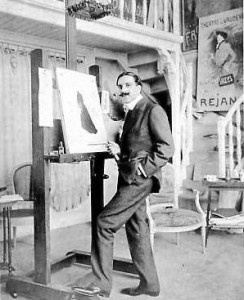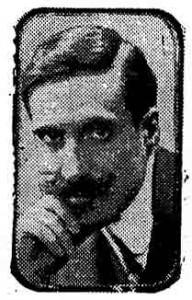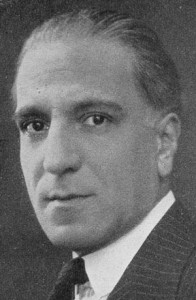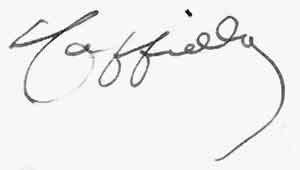Biography
The man
|
1875 |
Birth of Cappiello in Livorno (Italy). His father is a maritime liquidator, handling disputes between shipping companies, commission houses and private individuals. | |
|
1886 to 1892 |
First paintings. | |
|
1897 |
Spring: Cappiello goes to Paris to visit his brother who works at the Stock Exchange. Brief trip back to Livorno upon the death of his father. June: Return to Paris where he settles down definitively. | |
|
1896 to 1905 |
Caricaturing period. | |
|
1900 |
In November, he signs his first contract with the printer and publisher P. Vercasson, which marks the beginning of his career as a poster artist. | |
|
1901 |
Marries Suzanne Meyer, sister-in-law of Lucien Mühlfeld (literary critic) and Paul Adam (writer). They will have two children together. | |
|
1899 to 1942
|
Poster period. | |
|
1902 to 1913 |
Works for Vercasson, the publisher. | |
|
1914 |
Receives the Legion of Honor. | |
|
1914 to 1918 |
Called by Italy during the war to work as an interpreter in France for the Italian Information Services. He still finds some spare time to participate in charity events for the war-wounded, publish satirical caricatures at the expense of the Germans and make a few posters. | |
|
1919
|
After the armistice of 1918, he joins Devambez, the publisher, with whom he will work until 1936. | |
|
1921 |
He is promoted to officer of the Legion of Honor. | |
|
1928
|
He is promoted to commander of the Legion of Honor. | |
|
1930
|
He takes on French nationality. | |
|
1941 |
Sick, he retires to Grasse at his sister-in-law’s, Mrs Lucien Mühlfeld. | |
|
1942
|
Death of Cappiello in Cannes after having dinner with his friend André Rouveyre. He is remembered as an indulgent, very pleasant man, who epitomized Italian seduction, with a certain discretion which expressed obvious nobility. |
The immigrant
‘Paris, the city where people think the most, work the most…’
It was, I think, in April or May 1897 that I arrived in Paris, the day the fire of the Charity Bazaar plunged the entire city into dismay. In the streets, you could see horrified faces with inquiring looks, which resulted in a striking contrast with the splendor of that radiant spring day.
I had come to spend a month there as a tourist, as an amateur. I ended up staying there for thirty-five years. I think that that in itself is enough to express the hold Paris had over me. Although we always feel some reserve when it comes to expressing intimate and profound feelings, I will confess, since you want me to, that I love France in the same way a man can be in love with a woman. I love it for its beauty, for its spirit, for its harmony and for its generosity. I love it for its never ending love of Art. I don’t think there’s any other country in the world where an artist is welcomed, appreciated, encouraged as he is in France – and as I write these lines, I have one of the sweetest, most moving memories of my life in mind: the warm affectionate welcome I received from all my friends who were the most famous artists of that time, and the friendship which has bound us ever since.
I was 21 and crazy about all the beauty I was discovering. Paris offered too many subjects for the tourist that I was, for the artist in me to not take advantage of it and use it. Seduced by the indefinable and spiritual charm of Parisian women, I became passionate about transcribing this feeling through synthetic drawings. I showed them to friends who recommended that I publish them. I carried them to ‘Le Rire’ which published them immediately. The ‘Revue Blanche‘ then asked me for an album on actresses. Marcel Prévot wrote the preface. You can imagine my joy! Critics and chroniclers gave him an unforgettable welcome.
Henri Letellier, then director of the Journal, offered me a regular collaboration every Sunday, which reminds me of a charming lunch at Larue, where the great Caran d’Ache, with his usual kindness, wanted to persuade the little illustrator that I was to accept this collaboration, which my shyness initially prevented me from doing.
This happened in 1899. After Le Journal, Le Figaro, posters, etc., etc., and everywhere, the same friendliness, the same simplicity.
The smallest gifts, no matter which brand of human activity they were relevant to, were, in France, developed and multiplied. Thanks to its love and taste for this constant creation of thought, abrain never stays without evolving, without growing.
The entire world suffers its luminous radiance and influence to the point that each manifestation of the human genius comes to search a sort of spiritual sanction there.
It enlightens but is never blinding.
If I am asked the importance Paris plays in my global perception of France, I’ll answer: Paris immediately seemed to me like the place where elites choose to meet up and where the exchanges which go on there give it its deep and exceptional spirit. It is the most harmonious environment, the most sumptuous, and at the same time, the most intimate, it’s the city where people think the most, and where people work the most.
Can anyone not be moved by its beauty every time they follow the triumphal walk from Bastille to Etoile?’
His life’s work
|
1886 |
First paintings: a portrait of a man and a portrait of a woman (lost). He carries on his education in Livorno; his exercise books are covered in sketches. He starts copying old prints. |
|
1892 |
Without even attending a Fine Arts school or associating with any studio in particular, Cappiello knows most of the then contemporary painters in Livorno and Tuscany. He exhibits a large canvas for the first time in Florence: Woman in an interior (Livorno, G. Fattori Municipal Museum). |
|
1896 |
First album of caricatures: Lanterna Magica. Illustrates a dance card (lost). |
|
1898 |
Spring: Cappiello arrives in Paris where he goes to see his brother who works at the Stock Exchange. He returns briefly to Livorno upon the death of his father. June: He returns to Paris where he meets Puccini and the actor Novelli. July: Publication of his first two caricatures in Le Rire: Puccini and Novelli. Beginning of the series Les Contemporaines in Le Rire. First caricature of Réjane on the cover of Le Rire. First caricatures in Le Cri de Paris (Polin, Polaire…). |
|
1899 |
First drawings in La Rampe and in Le Sourire. Caricatural statuettes: Yvette Guilbert, Jeanne Granier, Réjane. End of May or beginning of June: Nos actrices, an album regrouping portraits of characters published by the Revue Blanche. First poster for Le Frou-Frou. He meets Toulouse-Lautrec for the first time. |
|
1900 |
First drawings in Le Journal (Sarah Bernhardt in ‘L’Aiglon’). Two posters in particular make him gain notoriety: Le Cachou Lajaunie and Les Amandines de Provence. |
|
1901 |
First drawings in Le Figaro. Two caricatures in L’Assiette au Beurre. Increase in his poster art activities: Corset le Furet, Odette Dulac, La Marquisette…. |
|
1902 |
Posters: Rentrée de Réjane in ‘La Passerelle’, Louise Balthy at the Folies Bergères. 28th of November: Gens du Monde, special edition of L’Assiette au Beurre. |
|
1903 |
April: Le Théâtre de Cappiello, special edition of the magazine Le Théâtre. He creates the poster for Chocolat Klaus, a real revolution in the world of advertizing art, then Katabexine, Le P’tit jeune Homme. |
|
1904 |
January: Les Contemporains Célèbres, first series, advertizing album for the firm Lefèvre-Utile, illustrated with 18 caricatures by Cappiello. Cappiello abandons caricature almost completely to devote himself mainly to poster art. Posters for Le Friquet, Xéres Pedro Domecq, Nouilles Ferrari.
|
|
1905 |
70 Dessins de Cappiello, a collection of caricatures previously published in the press, published by H. Floury. Portraits of Albert Emile Sorel and of Mme Lucien Mühlfeld. Posters for Anis Infernal, Portofino-Kulm, Bijoux Colin, Fleur des Neiges.
|
|
1906 |
Many posters: Menthe-Pastille, Esperantine, Pneu Continental, Torrilhon, Cognac Albert Robin. |
|
1907 |
Decorates Louis Dreyfus’ villa in Saint-Germain-en-Laye. Many portraits. Important posters: Angélus, Triple Sec Fournier, Maurin-Quina and more importantly the famous Thermogène.
He exposes his theory on poster art in Publicité Moderne.
|
|
1908 |
Exhibits the portrait of his brother-in-law Paul Adam at the Salon de la Comédie Humaine. Member of the Organization Committee of the 2nd Salon des Humoristes where he exhibits some of his work. Posters for the Source Parot, Xéres Quina Ruiz. |
|
1909 |
Exhibits the Portrait of his wife and his two children (Livorno Museum) at the Société Nationale des Beaux Arts, then at the Salon des Humoristes. Posters for Pippermint, Fernet-Branca, many posters published by Vercasson in South America. |
|
1910 |
Exhibits the portrait of Henri de Régnier (Orsay Museum) at the Société Nationale des Beaux Arts. Famous poster for Cinzano. |
|
|
1911 |
New contract with Vercasson. He makes a large number of posters: Vittel Grande Source, Longines, Oxo, Florio and more importantly the famous Chocolat Poulain. |
|
|
1912 |
Decorates the tea house, the reading room and the smoking lounge of the Galeries Lafayette. Many posters: Marie Brizard, Le Nil, Bière du Fort-Carré, Sacha Guitry Jean III. |
|
|
1913 |
Many posters: Villiod, Cigarettes Bastos, Lampe Visseaux, Chaussures Unic. |
|
|
1914 |
A few posters: Exposition Internationale de Lyon, L’Eclair. |
|
|
1915 |
Publishes a few etchings on the war and collaborates with La Baïonnette, Le Rire and Fontasio. |
|
|
1916 |
Cover of the original edition of the Poète Assassiné (The Poet Assassinated) by Apollinaire. A few posters: Le Trait-d’Union Franco-Italien, Thermo-Bloc. |
|
|
1919 |
Beginning of his collaboration with Devambez. Some posters: L’ Avenir, Poudre de Luzy.
|
|
|
1920 |
Once again member of the Committee of the Salon des Humoristes. Exhibits at the first Salon de la Publicité (Advertizing Exhibition) and in Beauvais at the Salon de l’Affiche (Poster Exhibition). Many posters: in particular the Blanchisseries Franco-Américaines, Mistinguett, Robur, Cachou Lajaunie. Decorates a grocery store on Jean Goujon street.
|
|
1921 |
Wins his case against the firm Chocolat Poulain which partially reproduced his poster modifying it slightly. Numerous posters for France and Italy: Bitter Campari, Café Martin, Imperméables Pirelli.
In November 1921, he signs an exclusivity contract with Devambez, the only authorized publisher of the Nouvelles Affiches Cappiello.
|
||
|
1922 |
Exhibits poster sketches at the Venice Biennial and at the French Institut in New-York. Many posters in France and Italy: Exposition Coloniale de Marseille, Parapluie-Revel, Restaurant Poccardi. |
||
|
1923 |
February-March: special exhibition of Cappiello’s life’s work at Devambez. Posters for the opening of the Théâtre de l’Etoile, Pâtes Ferrand-Renaud, Royat. |
||
|
1924 |
Posters for France, Italy and Spain: Ricqlès, Café con Leche Iberia, Bal de la Couture Parisienne. |
||
|
1925 |
Posters for Peugeot, Tana, Biscotti Wamar, L’Electrification, Studebaker. |
||
|
1926 |
Posters for cigarette brands Louis Doize, L’Eau des Abatilles, La Baule. |
||
|
1927 |
Posters for cigarette brands Laurens, Lane Borgosesia. |
||
|
1928 |
Ballet costumes and stage decor projects, at first for Sacha Guitry, then for Leonide Massine. Self-portrait ordered by the Uffizi Gallery in Florence. Posters for L’Ami du Peuple, Becuwe.
|
||
|
1929 |
Important posters, particularly the one for Savora. |
||
|
1930 |
Tapestry cartoons for the Manufacture Nationale de Beauvais on the theme of parrots. Illustrates La Princesse de Babylone (The Princess of Babylon) by Voltaire. Important posters for O Cap, Le Cuir which will mark an evolution in his poster art. |
||
|
1931 |
Exhibits his Parrots tapestries made by the Manufacture Nationale de Beauvais at the Exposition Coloniale (Colonial Exhibition). Very important poster for Bouillon Kub. |
||
|
1932 |
Exhibits at the Salon des Humoristes for which he makes the poster. Poster for Dubonnet, Marianne. |
||
|
1933 |
Posters for Gautier butter, La France de Bordeaux et du Sud-Ouest. |
||
|
1934 |
Important posters for Bally, L’Œuvre, Le Lorrain. |
||
|
1935 |
Decorates the fresco of the Dupont Restaurant’s bar, on boulevard Barbès. Exhibits at the Salon des Humoristes, participates in the Salon de l’Enseigne (Sign Fair). |
||
|
1936 |
Participates in the Milan Triennial and in the Exhibition of the French Poster in Prague. |
||
|
1937 |
La Force Motrice, decorates the 1937 exhibition at the Publicity Pavilion, where Cappiello is the Vice-President of the advertizing class. Posters for the Paris 1937 and the Accueil de la France. |
||
|
1938 |
Exhibits Les Dormeuses (The Sleepers) (Musée des Beaux-Arts in Lyon), a large canvas at the Salon de la Société Nationale des Beaux-Arts. A few posters: Mossant, Semaine de l’Enfance. |
||
|
1939 |
Participates in the Exhibition of Colored Posters from Chéret until today at the Conservatoire des Arts et Métiers in Paris. |
|
1941 |
Series of illustrations of Rimbaud poems (never published). |
|
1942 |
On his death, Cappiello leaves us with a considerable life’s work which will be the object of many exhibitions and retrospectives. |
|
1947 |
Retrospective at the Musée des Arts Décoratifs (Museum of Decorative Arts) in Paris. |
|
1960 |
Retrospective at the Casa della Cultura (House of Culture) in Livorno. |
|
1961 |
Exhibition at the Palais Saint-Pierre in Lyon. |
|
1962 |
Exhibition at the Musée d’Art et d’Histoire (Art and History Museum) in Geneva. |
|
1981 |
Retrospective at the Grand Palais in Paris. |
|
1993 |
Exhibition at the Mona Bismark American Center for Art & Culture in Paris. |
|
1994 |
Exhibition in Saint-Rémy-de-Provence (France). |
|
2003
|
Exhibition at the Musée des Beaux-Arts in Lyon. |
Biography taken and completed from: ‘Les Dossiers d’Orsay – Cappiello 1875 – 1942’, p186 and 187 © Réunion des Musées Nationaux, Paris 1981, ‘Dossiers d’Orsay’
Bibliography
Aside from exhibition catalogues, the main books on Cappiello are the following:|
1946 |
Jacques Viénot: ‘L. Cappiello sa vie et son oeuvre’ ( Preface by Jean Cocteau) – Editions de Clermont. |
|
1978 |
‘Cappiello et la Belle Epoque’ (Preface by Jacques de Lacretelle) – Editions Sciaky. |
|
2004 |
Jack Rennert: ‘Cappiello – The posters of Leonetto Cappiello – Editions The Poster Art Library. |
|
2011 |
Marie-Laure Soulié-Cappiello: ‘Cappiello – Catalogue raisonné des caricatures’ – Editions Sillages. |
|
2016 |
Francesca Cagianelli: ‘Leonetto Cappiello (1875 – 1942) Oltre L’Affiche’ – Editions Libreria Universitaria. |






